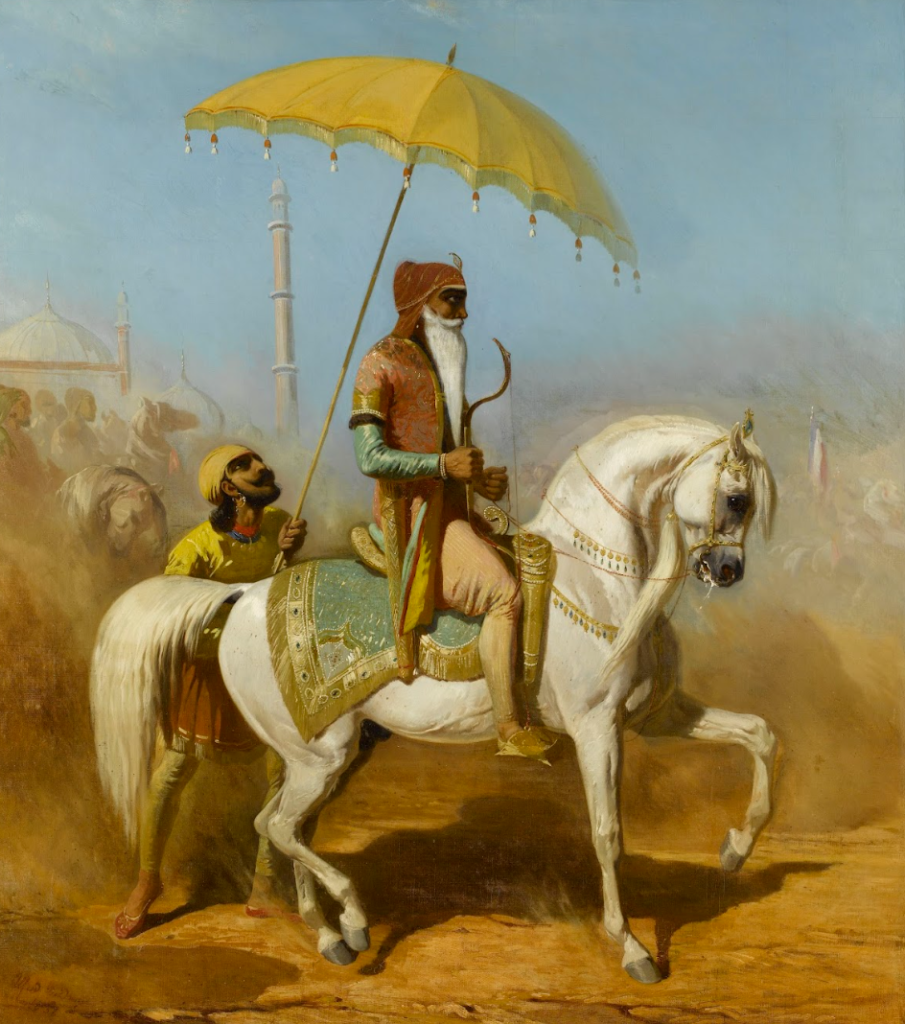
In a period riven with anarchy following decades of Afghan invasions, Ranjit Singh emerged as the Punjab region’s undisputed Maharaja by the turn of the 19th century. Possessed with an indomitable sense of destiny, his meteoric rise to power brought about the hugely influential Sikh Empire – a kingdom which created seismic change in the region, impacting the fortunes of the Mughal and British Empires and shaping the future of the Indian subcontinent.
Co-curated by Wallace Collection Director, Dr Xavier Bray, and guest curator and scholar of Sikh art, Davinder Toor, Ranjit Singh: Sikh, Warrior, King will present glittering weaponry, intricate miniature paintings and exquisite jewellery from the Sikh Empire, drawn from major public and private collections. Visitors will experience how this extraordinary individual brought about a golden age in which trade boomed, the arts flourished, and a formidable army was developed.
Featuring historic objects from Ranjit Singh’s court, courtiers and family members, including those personally owned by the Maharaja and the most famous of his wives, Maharani Jind Kaur, the exhibition will also display objects intimately connected with their son, Maharaja Duleep Singh – the deposed boy-king who was a favourite of Queen Victoria and the father of the prominent suffragette, Princess Sophia Duleep Singh.
The Wallace Collection is renowned as the home of one of the finest collections of arms and armour in the world, and the exhibition also affords an opportunity to showcase the Collection’s group of Sikh arms and armour, of which the star is a beautiful sword richly mounted in gold and gemstones, thought when acquired by the Marquess of Hertford, to have belonged to the Maharaja himself. For the first time in the museum’s history, the exhibition will place the Collection’s Sikh holdings in their historic and artistic context, showing them alongside other Sikh artworks.
Highlights of the works on show include an incredibly fine miniature painting of Ranjit Singh and his favourite, depicted in vibrant crimson, emerald and gold, on public display for the first time from the Toor Collection, and the dazzling throne made by Hafez Muhammad Multani for Ranjit Singh, a major loan from the Victoria & Albert Museum. Covered in thick beaten gold and lavishly ornamented, the Golden Throne epitomises the splendour of the Maharaja’s court.
At a time when revolutionary fervour was sweeping across France and America in the late 18th century, Ranjit Singh rose to power in the ancient region of Punjab, an area that today spans Pakistan and India.
Overcoming smallpox and sight loss in one eye, he was just 17 years old when he successfully led Sikh troops against the invading Afghan ruler Shah Zaman. Four years later he took Lahore from a larger rival Sikh confederacy and was proclaimed Maharaja of the Punjab in 1801. He went on to take Amritsar, the holiest of cities for Sikhs in 1802 and, by the time of his death in 1839, his territories covered large tracts to the north of the subcontinent, from the Khyber Pass to the borders of Tibet.
Although he was driven in his youth by an insatiable ambition for conquest, Ranjit Singh also formed political allegiances and became a patron of the arts, all while ruling with an equitable hand. Under his aegis, he brought about an unprecedented era of peace and prosperity to the region, noted for its religious tolerance and diverse, multicultural make-up. In return, he was hailed by his subjects as Sher-e-Punjab (‘Lion of Punjab’).
Ranjit Singh founded his extravagant durbar, or royal court, in the imperial walled city of Lahore. Sumptuous objects were produced to reflect the vibrant and potent power of his Empire, with examples of such objects in the exhibition demonstrating the sheer variety of cultural and artistic influences of this unique kingdom.
With his dominions centred in the plains adjacent to the Khyber Pass, Ranjit Singh was forced to quash the ambitions of the ferocious but disunited Afghan tribes on his north-western border. To seal his victories, the Maharaja took the fabled Koh-i-Noor diamond from the Afghans, which had been looted from the famous Peacock Throne of the Mughals during the Persian invasions of Nadir Shah. The Koh-i-Noor is now part of the British Crown Jewels.
Despite increasing tensions on the Sikh monarch’s southern border with the British East India Company, Ranjit Singh maintained cordial relations with his foreign neighbours but alive to their territorial ambitions, he began to modernise his army. Part of this process was the recruitment of Europeans – collectively known as Firangis (‘Franks’, foreigners) – including Company deserters, mercenaries and surgeons from Europe.
Foremost amongst the Firangis were four ex-Napoleonic officers who were instrumental in developing Franco-Sikh relations. Acknowledging Ranjit Singh’s remarkable feat of holding back the threat of a British invasion for four decades, they nicknamed their Sikh sovereign ‘The Napoleon of the East’.
Although the Empire quickly collapsed after his death, such is Ranjit Singh’s enduring legacy that, in 2020, he topped a poll of more than 5,000 readers of BBC World Histories magazine. With 38% of the votes, he emerged victorious as the greatest leader of all time, ahead of such leaders as Winston Churchill, Abraham Lincoln and Queen Elizabeth I.
Get your tickets here: https://wallacecollection.digitickets.co.uk/event-tickets/54724
WRITTEN BY: Nura Arooj















